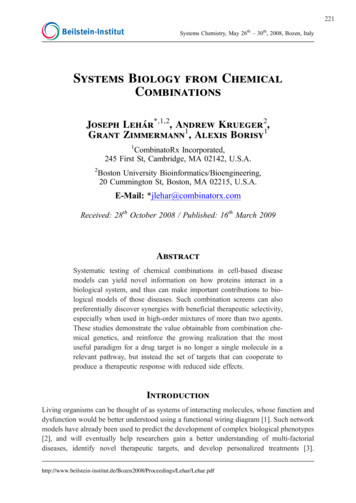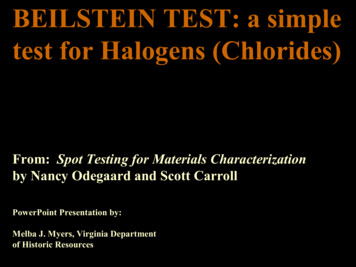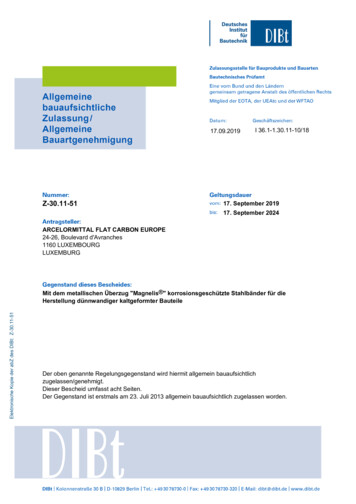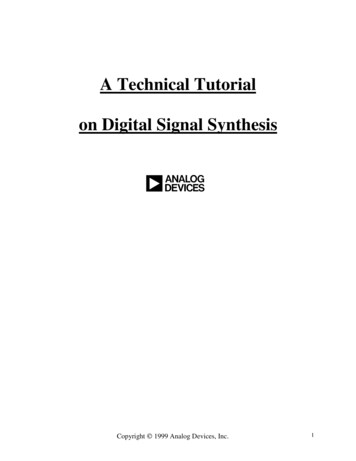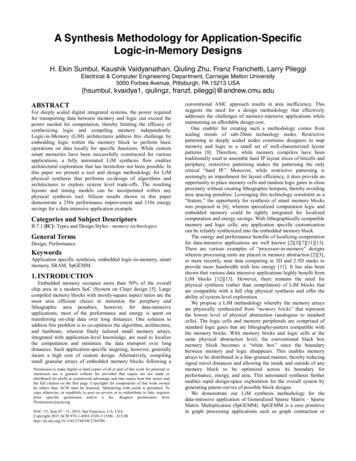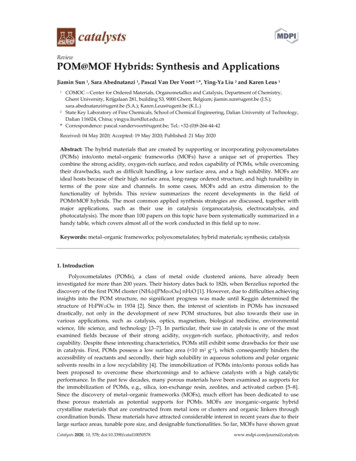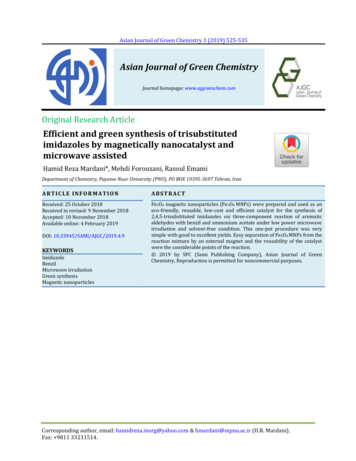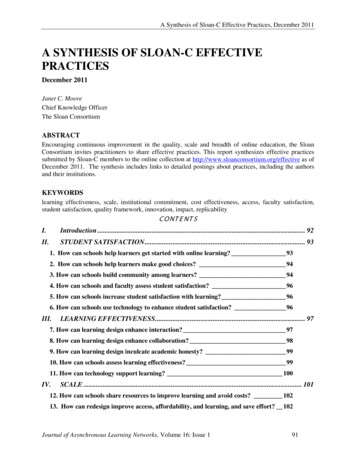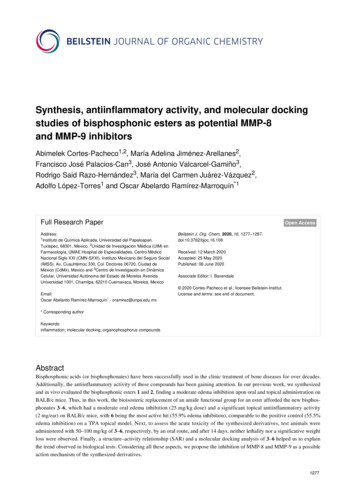
Transcription
Synthesis, antiinflammatory activity, and molecular dockingstudies of bisphosphonic esters as potential MMP-8and MMP-9 inhibitorsAbimelek Cortes-Pacheco1,2, María Adelina Jiménez-Arellanes2,Francisco José Palacios-Can3, José Antonio Valcarcel-Gamiño3,Rodrigo Said Razo-Hernández3, María del Carmen Juárez-Vázquez2,Adolfo López-Torres1 and Oscar Abelardo Ramírez-Marroquín*1Full Research PaperAddress:1Instituto de Química Aplicada, Universidad del Papaloapan.Tuxtepec, 68301, Mexico, 2Unidad de Investigación Médica (UIM) enFarmacología, UMAE Hospital de Especialidades, Centro MédicoNacional Siglo XXI (CMN-SXXI), Instituto Mexicano del Seguro Social(IMSS). Av. Cuauhtémoc 330, Col. Doctores 06720, Ciudad deMéxico (CdMx), Mexico and 3Centro de Investigación en DinámicaCelular, Universidad Autónoma del Estado de Morelos AvenidaUniversidad 1001, Chamilpa, 62210 Cuernavaca, Morelos, MexicoEmail:Oscar Abelardo Ramírez-Marroquín* - oramirez@unpa.edu.mxOpen AccessBeilstein J. Org. Chem. 2020, 16, 1277–1287.doi:10.3762/bjoc.16.108Received: 12 March 2020Accepted: 25 May 2020Published: 08 June 2020Associate Editor: I. Baxendale 2020 Cortes-Pacheco et al.; licensee Beilstein-Institut.License and terms: see end of document.* Corresponding authorKeywords:inflammation; molecular docking; organophosphorus compoundsAbstractBisphosphonic acids (or bisphosphonates) have been successfully used in the clinic treatment of bone diseases for over decades.Additionally, the antiinflammatory activity of these compounds has been gaining attention. In our previous work, we synthesizedand in vivo evaluated the bisphosphonic esters 1 and 2, finding a moderate edema inhibition upon oral and topical administration onBALB/c mice. Thus, in this work, the bioisosteric replacement of an amide functional group for an ester afforded the new bisphosphonates 3–6, which had a moderate oral edema inhibition (25 mg/kg dose) and a significant topical antiinflammatory activity(2 mg/ear) on BALB/c mice, with 6 being the most active hit (55.9% edema inhibition), comparable to the positive control (55.5%edema inhibition) on a TPA topical model. Next, to assess the acute toxicity of the synthesized derivatives, test animals wereadministered with 50–100 mg/kg of 3–6, respectively, by an oral route, and after 14 days, neither lethality nor a significative weightloss were observed. Finally, a structure–activity relationship (SAR) and a molecular docking analysis of 3–6 helped us to explainthe trend observed in biological tests. Considering all these aspects, we propose the inhibition of MMP-8 and MMP-9 as a possibleaction mechanism of the synthesized derivatives.1277
Beilstein J. Org. Chem. 2020, 16, 1277–1287.IntroductionBisphosphonic acids (or bisphosphonates) are organophosphorus compounds characterized by a P–C–P moiety. Theseorganic compounds are valuable drugs for the treatment of bonediseases as osteoporosis, Paget’s disease, and malignant hypercalcemia [1-3]. Specifically, bisphosphonates act as osteoclastresorption inhibitors, augmenting the bone density andpreventing osteoporosis [4]. Moreover, some bisphosphonateshave gained attention as potential antiinflammatory agents by invitro and in vivo assays [5-8]. Additionally, bisphosphonateshave been reported as inhibition and downregulation matrixmetalloproteinase (MMP) agents [9-11]. In this regard, MMPsare a family of extracellular proteinases (24 isoenzymes inhuman) involved in tissue regeneration and are closely relatedto physiologic and physiopathological processes, such asinflammation, angiogenesis, and metastasis in cancer [12-15],pointing at bisphosphonates as potential treatments for cancerand other inflammation-related diseases. In this respect, MMPinhibition by phosphonates or bisphosphonates has been previously studied through computational or X-ray diffractionanalyses to describe the enzyme inhibitor site binding modes[16-18].Thus, in this work, the bisphosphonates 3–6 were synthesizedby a two-step method and then evaluated through two in vivoacute inflammation models in BALB/c mice. Furthermore, theacute toxicity was determined for these derivatives, and molecular docking studies were performed to account for a possibleaction mechanism as MMP-8 and MMP-9 inhibitors.Results and DiscussionChemistryAs part of our ongoing interest in the discovery of new antiinflammatory agents, our research group have previouslyaddressed the synthesis and in vivo antiinflammatory activityevaluation of the bisphosphonic esters 1 and 2, observing activity by oral (carrageenan model) and topical administration (TPAmodel) in BALB/c mice (Figure 1) [19].Figure 1: Previously reported antiinflammatory bisphosphonates 1 and2. edema inhibition (in %, carrageenan model, 50 mg/kg) for 1: 7.0; for2: 22.2.Furthermore, in the search of more potent and low-toxicity derivatives, in this work, we have focussed our attention on themolecular modification of the derivatives 1 and 2 through thebioisosteric replacement [20] of the amide functional group byan aliphatic or aromatic ester. The potential antiinflammatoryactivity of the new bisphosphonates was predicted using thePrediction of Activity Spectra for Substances (PASSOnline)database, which compares the molecular structure of test compounds vs a large training set of experimental bioactive or inactive compounds [21]. The results of the prediction are summarized as probability of activity (Pa) and probability of inactivity(Pi) values, both ranging from 0 to 1 (Figure 2), where a higherPa value is desired. Thus, a Pa value of new bisphosphonates the Pa value of 1 and 2 was the applied inclusion criterion inthis study. As can be seen in Figure 2, the Pa is greater for thenew derivatives 3–6 (0.63–0.77) compared to the previous bioactive compounds 1 and 2 (0.51). In order to explore the SAR inthe proposed compounds 3–6, we evaluated the effect of thevolume of the ester group by the inclusion of ethyl or tert-butylsubstituents in the aliphatic derivatives 3 and 4. On the otherhand, the replacement of the aliphatic chains by an aromaticportion led us to the derivatives 5 and 6 where the effect ofbenzyl or 4-methoxybenzyl substituents was assessed(Figure 2).Furthermore, the bisphosphonic esters 3–6 passed the Lipinski’srules [22] as criteria for drugs for an oral administration as weFigure 2: Designed bisphosphonic esters as antiinflammatory agents.1278
Beilstein J. Org. Chem. 2020, 16, 1277–1287.wanted to test these derivatives through in vivo acute inflammation models [23]. Then, the above-named derivatives were synthesized in a first stage by the esterification of bromoacetyl bromide and the corresponding alcohol. The reaction of ethyl ortert-butyl alcohol and bromoacetyl bromide in the presence oftriethylamine in CH2Cl2 yielded the bromoaceto esters 7 and 8in 42 and 71% yield (Scheme 1b, method A). Nonetheless,when benzyl or 4-methoxybenzyl alcohol were used under thesame reaction conditions, 9 and 10 were obtained in poor yields.Thus, the subsequent use of NaHCO3 as a base in CH3CN [24]afforded the bromoaceto esters 9 and 10 in 71 and 91% yield(Scheme 1b, method B). It is important to note that 4-methoxybenzyl alcohol was prepared by the reduction of 4-methoxybenzaldehyde (Scheme 1a).Next, the treatment of tetraethyl methylenediphosphonate withNaHMDS under an anhydrous atmosphere, followed by the addition of 7–10, respectively, afforded the final products 3–6, respectively, in 41–73% yield (Scheme 2).Pharmacological activityWith the target compounds on hand, we proceed to evaluatethem with two acute inflammation models: a) 12-O-tetrade-canoylphorbol-13-acetate (TPA) through topical administration[25] and b) a carrageenan model, through oral administration[25]. When the bisphosphonates 3–6 (2 mg/ear) were assayedwith a TPA model, the derivatives 5 (40.7% edema inhibition)and 6 (55.9% edema inhibition) were the most active ones, with6 having a comparable edema inhibition to the positive control(indomethacin, 55.5% edema inhibition, Table 1). Nevertheless,the derivatives 3 and 4 exhibited a moderate antiinflammatoryactivity (25.5% and 23.9% edema inhibition, respectively).Thus, the inclusion of an aromatic ring in the derivatives 5 and6 clearly potentiated the desired pharmacological effect onmice. The rationale behind this could be the difference inlipophilicity between the aliphatic esters 3 and 4, which wereless lipophilic (by means of the clogP value of 0.58 and 1.39,respectively) compared to the aromatic derivatives 5 and 6(clogP 1.80 and 1.85, respectively), with the last being themost permeable one through mice skin (Table 1). Nevertheless,it is important to note that the aliphatic derivatives 3 and 4considerably differed in the clogP value between each other(0.58 and 1.39) but had a comparable edema inhibition, indicating that for this study, the volume of the ester group had littleimportance for the pharmacological activity. More importantwas the replacement of the aliphatic for an aromatic residue inScheme 1: Synthesis of the intermediate bromoaceto esters 7–10.Scheme 2: Synthesis of the bisphosphonates 3–6.1279
Beilstein J. Org. Chem. 2020, 16, 1277–1287.Table 1: Antiinflammatory activity of 3–6 using a TPA topical model. 2 mg/ear of the test compounds was used.atreatmentauricular edema (mg)% inhibitionclogPbDE50 (mg/ear)TPA8.80 mg 0.46–––indomethacin (2 mg/ear)3.92 mg 0.37c55.5––36.56 mg 0.19c,d25.50.58n.d.46.70 mg 0.39c,d23.91.39n.d.55.22 mg 0.37c,d40.71.801.463.88 mg 0.21c55.91.850.9aThedata is presented as mean standard error (s.e.). The percentage of inhibition of the edema is given in respect to the TPA group. Statisticalanalysis one-way ANOVA, post hoc SNK test (p 0.05). bCalculated using the Molinspiration property engine v2018.10b [31]. cVs TPA control. dVsindomethacin; n 5.the ester group, leading to the more active derivatives 5 and 6.The clogP value of 5 and 6 was more similar between them, buta remarked difference in the edema inhibition was observed(40.7 vs 55.9%), indicating that the introduction of an electrondonating 4-methoxy substituent on the phenyl ring of 6 potentiated the antiinflammatory activity compared to the nonsubstituted derivative 5. Next, the DE50 value was assessed for themore interesting targets 5 (DE50 1.4 mg/ear) and 6 (DE50 0.9 mg/ear), with the methoxy derivative 6 having a higher potency and efficacy (55.9% edema inhibition) in the series(Table 1). Our results were in good accordance with theprevious observation of the antiinflammatory activity of the fewbisphosphonic esters [26-30].Next, the antiinflammatory activity of the bisphosphonates 3–6was assayed with a carrageenan model by intragastric administration. As can be seen in Table 2, the derivatives 3 and 4 werethe more active ones this time (24.6% and 20.9% edema inhibition, respectively). A remarkable difference was observed forthe derivatives 5 (13.8% edema inhibition) and 6 (9.1% edemainhibition) where a low antiinflammatory activity was observed.In this regard, a clear correlation between the experimental andpredicted activity was observed. Thus, the compounds 3 and 4were predicted to be more bioactive than 5 and 6 (Table 2). Additionally, this tendency was strongly connected to the clogPvalue, where the edema inhibition was inversely proportional tothe clogP value (Table 2). Thus, the higher the predicted Pa andthe lower the clogP, the higher the observed activity. It is worthto mention that the oral efficacy of the tested compounds wasopposed to that observed with the TPA topical model. This maybe a consequence of the lower lipophilicity of 3 (clogP 0.58)and 4 (clogP 1.39) compared to 5 (clogP 1.80) and 6(clogP 1.85), influencing the better dissolution of 3 and 4 inan aqueous medium prior to its absorption through gut mice(Table 2). Finally, the synthesized bisphosphonates 3 and 4have proven to be more active (24.6% and 20.9% edema inhibition, respectively, at a 25 mg/kg dose) by oral administrationthan the parent compounds 1 and 2 (7.0% and 22.2% edemainhibition, respectively, at a 50 mg/kg dose, Figure 1) [19]. Inaddition, 3 and 4 had a comparable activity than what was reported for other bisphosphonic esters [30].Following this, the acute toxicity of 3–6 was determinedthrough one oral administration of 50 or 100 mg/kg in BALB/cmice, and after 14 days, no significant weight loss or lethalitywas observed in the individuals. Additionally, the post-mortemTable 2: Antiinflammatory activity of 3–6 with a carrageenan oral model. Test compounds: 25 mg/kg.atreatmentpaw edema (mm)b% inhibitionPaclogPccarrageenan0.830 0.017d–––indomethacin (20 mg/kg)0.530 0.04d36.1––30.626 0.03d,e24.60.770.5840.657 0.02d,e20.90.711.3950.716 0.03d,e13.80.661.8060.755 0.06e9.10.631.85aThedata is presented as mean standard error (s.e.). The percentage of inhibition of the edema is in respect to the carrageenan group. Statisticalanalysis one-way ANOVA, post hoc SNK test (p 0.05). bAt 5 h. cCalculated using Molinspiration property engine v2018.10b [31]. dVs controlcarrageenan. eVs indomethacin; n 5.1280
Beilstein J. Org. Chem. 2020, 16, 1277–1287.inspection of the kidneys, heart, and bowel of the experimentalmice did not show any significant weight differences to thecontrol group (Supporting Information File 1, Table 1, andTable 2).Lastly, in order to acknowledge a potential mechanism of actionof the bisphosphonates 3–6, we propose that the tested derivatives are acting as MMP inhibitors. In this respect, MMP-8 andMMP-9 isoenzymes are related to inflammatory processes indifferent tissues [32-35]. Furthermore, for MMP-8 and MMP-9,enzyme–inhibitor interaction modes are well known. For example, the coordination of the P O oxygen atom in bisphosphonates with a zinc cation in the catalytic site of the MMPs hasbeen characterized, both through X-ray diffraction and molecular docking studies [11,36,37]. Consequently, we proposeMMP-8 and MMP-9 as potential biological
Beilstein J. Org. Chem. 2020, 16, 1277–1287. 1280 Table 1: Antiinflammatory activity of 3–6 using a TPA topical model. 2 mg/ear of the test compounds was used.a treatment auricular edema (mg) % inhibition clogPb DE50 (mg/ear) TPA 8.80 mg 0.46 – – – indomethacin (2 mg/ear) 3.92 mg 0.37c 55.5 – – 3 6.56 mg 0.19c,d 25.5 0.58 n.d.
